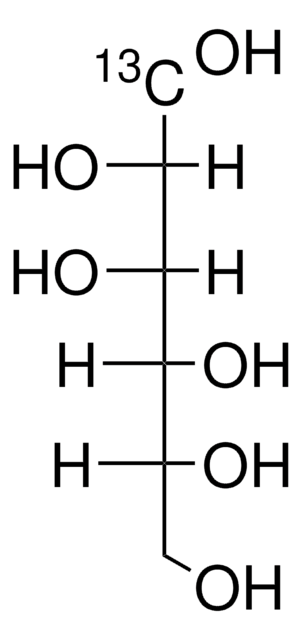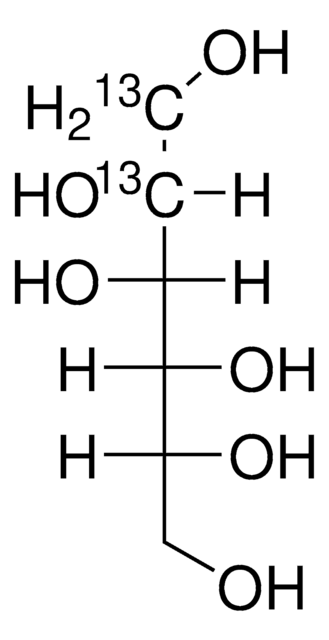추천 제품
제품 라인
BioXtra
Quality Level
분석
≥98% (HPLC)
형태
powder
불순물
≤0.0005% Phosphorus (P)
≤0.01% Insoluble matter
무기 잔류물
≤0.01%
색상
white
유용한 pH 범위
5.0-6.5 (25 °C, 182 g/L)
mp
167-170 °C (lit.)
solubility
H2O: 1 M, clear, colorless
음이온 미량물
chloride (Cl-): ≤0.05%
sulfate (SO42-): ≤0.05%
양이온 미량물
Al: ≤0.0005%
Ca: ≤0.0005%
Cu: ≤0.0005%
Fe: ≤0.0005%
K: ≤0.005%
Mg: ≤0.0005%
NH4+: ≤0.05%
Na: ≤0.005%
Pb: ≤0.001%
Zn: ≤0.0005%
SMILES string
OC[C@@H](O)[C@@H](O)[C@H](O)[C@H](O)CO
InChI
1S/C6H14O6/c7-1-3(9)5(11)6(12)4(10)2-8/h3-12H,1-2H2/t3-,4-,5-,6-/m1/s1
InChI key
FBPFZTCFMRRESA-KVTDHHQDSA-N
유사한 제품을 찾으십니까? 방문 제품 비교 안내
일반 설명
D-Mannitol is the alcohol form of mannose. Its molar mass is 182 g/mol. Mannitol is present widely in plants, fungi and algae. It is extracted mainly from seaweeds. It is used in food for diabetic patients as it is absorbed slowly. It is commonly used as a stabilizer, humectant, nutritive sweetener and bulking agent in food.
애플리케이션
D-Mannitol has been used:
- as a hydroxyl radical inhibitor, to detect the hydroxyl radical generation during the reactive oxygen species (ROS) modification of chromatin
- in [3H]-mannitol permeability assay and also as a component in buffer B for measuring the transmonolayer dilution potentials
- as a component in extracellular recording solution for whole cell patch clamp recordings
생화학적/생리학적 작용
D-Mannitol is used as an osmotic agent for the treatment of brain swellings.
A sugar alcohol sweet tastant. Used in sweetness inhibition studies.
기타 정보
To gain a comprehensive understanding of our extensive range of Sugar alcohols for your research, we encourage you to visit our Carbohydrates Category page.
Storage Class Code
11 - Combustible Solids
WGK
WGK 1
개인 보호 장비
Eyeshields, Gloves, type N95 (US)
이미 열람한 고객
Sweeteners: Nutritional Aspects, Applications, and Production Technology, 59-59 (2012)
Methods to examine tight junction physiology in cancer stem cells: TEER, paracellular permeability, and dilution potential measurements
Buchert M, et al.
Stem Cell Reviews and Reports, 8(3), 1030-1034 (2012)
Neurology of the Newborn, 459-459 (2008)
Allosteric interactions between NMDA receptor subunits shape the developmental shift in channel properties
Sun W, et al.
Neuron, 94(1), 58-64 (2017)
Antibodies against 4-hydroxy-2-nonenal modified epitopes recognized chromatin and its oxidized forms: role of chromatin, oxidized forms of chromatin and 4-hydroxy-2-nonenal modified epitopes in the etiopathogenesis of SLE
Al-Shobaili HA, et al.
Disease Markers, 33(1), 19-34 (2012)
자사의 과학자팀은 생명 과학, 재료 과학, 화학 합성, 크로마토그래피, 분석 및 기타 많은 영역을 포함한 모든 과학 분야에 경험이 있습니다..
고객지원팀으로 연락바랍니다.






